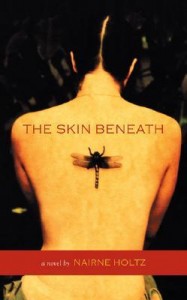 The Skin Beneath
The Skin Beneath
by Nairne Holtz
Insomniac Press. 265 pages, $16.95
THIS ACCOMPLISHED FIRST NOVEL by a bibliographer of Canadian lesbian fiction is classified by the publisher as a “lesbian mystery.” However, it could as well be described as a black comedy of manners, a road-trip novel, a study of grief in various forms, a realistic lesbian love story, or a novel of development. The central character, Sam (for Samantha), is moved to investigate the life of her deceased sister Chloe when she gets an anonymous note suggesting that Chloe’s death in a legendary hangout for bohemians in New York was not an accident (from a drug overdose), as she had been told.
As in other novels featuring two siblings, Sam and Chloe display contrasting traits in adulthood that were foreshadowed in their insular childhood. Chloe, six years older than Sam, was always heterosexual if never exactly “straight.” In shared games, Chloe usually assigned Sam the less desirable role of “the boy.” Sam has grown up butch and queer.
The narrative style is as coolly understated as Sam’s stream of consciousness but expressed in a distancing third-person voice. Current events are told in the present tense, interspersed with flashbacks in the past tense. The reader learns that Chloe and Sam were raised by their academic father, who quietly acquired a male lover after expelling the girls’ suicidal mother from their home. In some sense Chloe played the role of mother to Sam, and her absence still leaves a huge gap in Sam’s life. When Sam and her father converse, he discusses “his and Steven’s consumer choices: what downtown restaurant they tried… and what new pottery they bought.” Sam has been raised in an atmosphere of subtle dishonesty that maintains a strict silence on all matters emotional.
Sam is described as a much-tattooed slacker of the 1990’s who takes university courses but never gets a degree. She acquires a mission in life when she moves from Toronto to Montreal to discover what she can about her sister’s life there. There she’s relieved to find a job as dishwasher in the Montreal restaurant where Chloe once worked. Sam’s chronic unemployment is due in part to her androgynous image, which makes her ineligible for the kind of “display jobs” (receptionist, waitress, salesperson, stripper) that are usually available to young women with few specific skills. The restaurant, Le Lapin Blanc (The White Rabbit), is the opening through which Sam enters a surrealistic underworld to rival that of Lewis Carroll’s in Alice in Wonderland and Through the Looking-Glass. Indeed, references to the “Alice” books recur throughout the novel.
Sam is aware that Chloe had been influenced by the socio-political theories of Noam Chomsky and Michel Foucault, whose work she had discovered in university. She also knows that Chloe was fascinated by conspiracy theories. Sam eventually discovers an article co-written by Chloe, like a letter from the grave, outlining a conspiracy that links illegal weapons, the CIA, the Hell’s Angels, and the Raelian cult with recent U.S. military interventions in the Middle East. The novel’s title, “The Skin Beneath,” refers to the “Ecdysis Conspiracy” (possibly named by Chloe herself), which in turn refers to the natural process by which snakes shed their outer skins to reveal new skin beneath. The truth is similarly shown to be provisional and multi-layered.
As Sam meets the motley crew of those who knew Chloe in her last few years, a cavalcade of representative social types, she follows the trail of clues to Detroit and to her sister’s terminus at the Chelsea Hotel in New York. Sam’s objectivity on this journey is compromised by her sexual attraction to two feminine women who return her lust, but who both seem untrustworthy in different ways. In the end, Holtz’s story of urban life in the 90’s is shown to be in the tradition of Edgar Allan Poe’s tale, “The Purloined Letter,” in which the most important piece of evidence is hidden in plain sight.
Holtz evokes particular places and subcultures with impressive accuracy, yet the essential plot seems timeless. Chloe’s emerging life story is heartbreaking, and Sam’s sense of sharing in the guilt of all those who hurt Chloe seems justified, yet guilt is shown to be useless when it involves making amends with someone who’s dead. By the end of the story, the mystery of Chloe’s death is resolved much differently from the way this would happen in a conventional “whodunit,” and a sequence of apparently unrelated events and characters comes together in a way that is satisfyingly coherent.
____________________________________________________________________
Jean Roberta is a widely published writer based in Regina, Saskatchewan.





